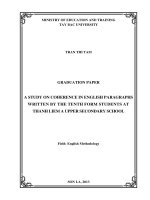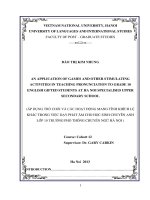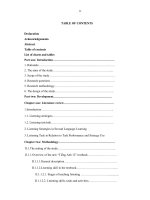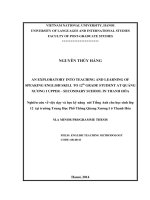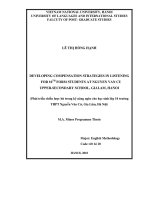Learners’ anxiety in speaking lessons at Nguyen Quan Nho upper secondary school Causes and solutions
Bạn đang xem bản rút gọn của tài liệu. Xem và tải ngay bản đầy đủ của tài liệu tại đây (144.06 KB, 6 trang )
Learners‟ anxiety in speaking lessons at Nguyen
Quan Nho upper secondary school: Causes and
solutions
Lưu Thị Hồng Sâm
Trường Đại học Ngoại ngữ
Luận văn ThS. Chuyên ngành: Theory and methodology of English teaching
Mã số: 60 14 10
Người hướng dẫn: Nguyen Bang, MA.
Năm bảo vệ: 2011
Abstract: The present study is concerned with sources of speaking anxiety on the basis
of learners‟ responses presented in the survey questionnaire and in the informal
interview. The quantitative questionnaire first examined the existence of speaking anxiety
and factors causing students‟ anxiety when speaking English. The qualitative interview
further looked at sources of students speaking anxiety. A total of 135 tenth form students
at Nguyen Quan Nho high school, Thanh Hoa province participated in the survey. The
results showed that the tendency of students‟ nervousness was obvious. Based on
students‟ explanations, factors viewed as causing anxiety was divided into four
categories: the content of the lessons, communication apprehension, test anxiety and fear
of negative feedback. From the students‟ suggestions in the interview, the researcher
proposed some strategies for students and teachers to ameliorate negative effects of
speaking anxiety. It is also hoped that this research will be of some help to Vietnamese
learners and teachers in general in having a better understanding of the nature of FLA and
speaking anxiety in particular to improve the teaching and learning of English.
Keywords: Phương pháp giảng dạy; Kỹ năng nói; Tiếng Anh
Content
PART A: INTRODUCTION
1. Rationale
Nowadays, English is considered as an international language, which is spoken by millions of
people all over the world. The number of people who desire to learn English has multiplied.
Some learn English to get more wisdom, some wish to get well-paid jobs, some learn English for
other purposes. That is why English has been now widely taught in almost all educational
institutions, at every level.
In Vietnam, English is being taught as a compulsory subject and it is one of the six subjects in
the national examination that students have to pass if they want to get General Certificate of
Secondary Education (G.C.S.E). In recent years, the teaching of foreign language in Vietnam has
seen a remarkable change in methodology, followed by a new approach to language teaching.
That is Communicative Language Teaching. This approach represents a fundamental shift in the
teaching-learning process from structure mastery to communicative competence. Accordingly,
learners‟ ability to communicate becomes its first priority, which means that when learning
English, learners have to grasp all the four skills: speaking, reading, writing, and listening
because those skills are integrated with one another. Speaking well is of great importance to
students when communicating with others in a second language, not only in teaching and
learning environments, but also outside the classroom. The students should be able to speak in a
well structured way and develop their ability to take part in conversations, discussions and
negotiations and to express with subtlety their own views and consider those of others. Speaking
does not only reflect the speaker‟s social and cultural background, but is also a part of speaker‟s
identity. However, among the four skills, speaking seems to be the most difficult one but paid the
least attention to in most high schools. Speaking has only become a compulsory skill in the
curriculum since the new English textbook was officially put into use in 2006. This results in
numerous problems inflicting students in learning the speaking skills, one of which is Foreign
Language Learning Anxiety. Besides, having considerable levels of anxiety in the classroom has
been regarded as an experience that is more likely to occur in foreign language lessons than in
other subjects. This seems natural as in foreign language classroom the students have to use
foreign language - an instrument they are not familiar with - to sustain communication. As a
teacher of English, I have noticed that my students often experience foreign language anxiety in
speaking skills. Some students experience pressure when being asked to speak in front of the
whole class because they fear criticism. Some may feel nervous since they lack of vocabulary to
express their ideas; consequently, they may tremble and stutter, etc. Such situation has inspired
me to carry out a study on learners‟ anxiety in speaking skills to identify the causes and give
solutions to alleviate students‟ anxiety in learning speaking.
2. Aims of the study
The major purpose of the research is to find out factors or causes that make students stressful and
nervous in speaking English and suggest some solutions to alleviate English speaking anxiety in
the students.
3. Research questions
To fulfill the above aims, the study is carried out with an attempt to answer the following
questions:
1. What are the possible causes that make students at Nguyen Quan Nho upper
secondary school anxious and nervous in learning speaking?
2. What are the possible solutions to reduce speaking anxiety of the students?
4. Scope of the study
FLA exits in the process of learning all the four skills. However, only students‟ speaking anxiety
is focused on in this research with its causes in terms of contents of the lessons, communication
apprehension, test anxiety and fear of negative feedback and solutions based on each source of
anxiety. Due to the local condition constraints, this study only involves one hundred and thirty-
five 10
th
form students at Nguyen Quan Nho High School.
5. Significance of the study
This study could be of some help to teachers and students at Nguyen Quan Nho upper secondary
school:
(i) to improve the teachers‟ theoretical understanding of foreign language anxiety,
especially the causes of speaking anxiety.
(ii) to enhance the students‟ awareness of causes of speaking anxiety they have in
foreign language, and from this they can control and overcome their nervousness in
speaking skills. Hopefully, the possible solutions suggested in this research can help
learner reduce the speaking anxiety and motivate them to learn and make progress in
speaking.
6. Method of the study
In order to realize the above aims of the study, quantitative method was mainly used. The data
collected for the study came from the 10
th
grade students. Survey questionnaire was used to
gather information and evidence for the study.
In addition, to make the data collected more reliable and authentic, qualitative method was
applied with two instruments: a follow up interview and an informal observation.
All the comments, remarks, recommendations and conclusion provided in the study were based
on the data analysis of the study.
7. Design of the study
This study is divided into three parts:
Part A – Introduction presents the rationale, the aims, the research questions, scope, significance,
methods as well as the design of the study.
Part B – Development contains three chapters. Chapter one reviews the literature in terms of
speaking, foreign language anxiety in general and speaking anxiety in particular. Chapter two
presents the study. Chapter three mentions some suggested solutions to reduce speaking anxiety.
Part C – Conclusion presents a summary of the study and concluding comments derived from the
findings of the study. It also discusses the limitation of the study and suggestion for further
research.
REFRENCES
Aida, Y. (1994). Examination of Horwitz, Horwitz and Cope‟s construct of foreign
language anxiety. The case of students of Japanese. The Modern Language Journal,
78, pp.155-168.
Ando, M. (1999). Distinctive Language Anxiety Factors among College Students: Toward
the further development of measures and theories. Unpublished doctoral dissertation,
State University of New York, Buffalo.
Arnold, J. (1999). Affect in Language Learning. Cambridge: Cambridge University Press.
Balley, K. M. (2005). Practical English Language Teaching: Speaking. McGraw Hill, Inc.
Brown, H. D. (2007). Principles of Language Learning and Teaching (5
th
Ed.).
New York: Longman
Bygate, M. (1997). Speaking.(6
th
ed.). Oxford University Press.
Daly, J. (1991). Understanding Communication Apprehension: An Introduction For
Language Educators. Upper Saddle River, NJ: Prentice Hall, Inc.
Darwin, C. R. (1872). The Expression of Emotion in Man and Animals.
London: John Murray.
Freud, S. (1920). A General Introduction to Psychoanalysis (Vorlesungen zur fuhung in
diePsychoanalyse). New York: Boni & Liveright.
Gregersen, T., & Horwitz, E. K. (2002). Language learning and perfectionism: Anxious
and non-anxious language learners‟ reactions to their own oral performance. The
Modern Language Journal, 86(3), pp.562-570.
Guiora, A., et al. (1972). Empathy and Second Language Learning. Language Learning,
22, pp.111-130.
Hoang Van Van, et al. (2006). Tiếng Anh 10. Nhà Xuất Bản Giáo Dục.
Horwitz, E. K., (2001). Language Anxiety and Achievement. Annual Review of Applied
Linguistic, 21, pp.112-126.
Horwitz, E. K., Horwitz, M. B., & Cope, J. (1986). Foreign language classroom anxiety.
Them Modern Language Journal, 70(2), pp.125-132.
Horwitz, E. K & Young, D. J (Eds.). (1991). Language Anxiety: From Theory and
Research to Classroom Implications. Englewood Cliffs, NJ: Prentice Hall.
Kayi, H. (2006). Teaching Speaking, 12(11). Retrieved from:
Kitano, K. (2001). Anxiety in the college Japanese language classroom. The Modern
Language Journal, 85, pp.549-566.
Liu, M. (2007) Anxiety in oral English classrooms: A case study in China. Indonesian
Journal of English Language Teaching, 3(1), pp.119-137.
MacIntyre, P. D. (1995). How does anxiety affect second language learning? A reply to
Sparks and Ganschow. The Modern Language Journal, 79, pp.88-99.
MacIntyre, P. D. (1999). Language anxiety. A review of the research for language
teachers. In D.J. Young (Eds.), Affect in foreign language and second language
learning: A practical guide to creating a low-anxiety classroom atmosphere
Boston: McGraw-Hill, pp.24-25
MacIntyre, P. D., & Gardner R. C. (1991a). Anxiety and Second Language Learning:
Towards a Theoretical Clarification. In: E. K. Horwitz & D. J. Young (Eds.),
Language Anxiety: From Theory and Research to Classroom Implications Englewood
Cliffs, New Jersey: Prentice Hall, pp.41-54
MacIntyre, P. D., & Gardner R. C. (1991b). Method and results in the study of anxiety and
language learning: A review of literature. Language learning, 41, pp.85-116.
Nunan, D. (1991). Language Teaching Methodology. NJ: Prentice Hall International
Oxford, R. (1999). “Style wars” as a source of anxiety in language classrooms. In Affect in
foreign language and second language learning: A practical guide to creating a low-
anxiety classroom atmosphere, edited by D. J. Young, Boston, MA: McGraw-Hill
College. pp. 216-237
Palacios, L.M. (1998). Foreign language anxiety and classroom environment: A study of
Spanish university students. Unpublished doctoral dissertation, The University of
Texas, Austin.
Pattison, P. (1992). Developing Communication Skills. Cambridge: CUP.
Price, M. Lou. (1991). The subjective experience of foreign language anxiety: Interview
with highly anxious students. In Horwitz, E. K and Young, D. J (Eds.), Language
anxiety: From Theory and Research to Classroom Implications New
Jersey: Prentice Hall, pp.101-108
Samimy, K. (1994). Teaching Japanese: Consideration of Learners‟ Affective Variables.
Theory into Practice, 33(1), pp.29-33.
Scovel, T. (1978). The effect of affect on foreign language: A review of the anxiety
research. Language learning, 28 (1), pp.129-142.
Scovel, T. (1991). „The Effect of Affect on Foreign Language Learning: A Review of the
Anxiety Research.‟ In Horwitz, E. K., & Young, D.J (eds.) Language Anxiety: From
Theory and Research to Classroom Implications. Englewood Cliffs, Nj: Prentice Hall.
Spielman, G., & Radnofsky, M. L. (2001). Language learning under tension: New
directions from a qualitative study. The Modern Language Journal, 85, pp.259-278.
To Thu Huong, et al. (2008). EST Methodology II. Unpublished, University of Languages
& International Studies
Tsiplakides, I., & Keramida, A. (2009). Helping students overcome foreign language
speaking anxiety in the English classroom: Theoretical issues and practical
recommendations. International Education Studies, 2(4), pp.39-44.
Ur, P. (1996). A Course in Language Teaching, Practice and Theory. CUP.
Young, D. J. (1990). An investigation of students‟ perspectives on anxiety and speaking.
Foreign Language Annals, 23, pp.539-553.
Young, D. J. (1991). Creating a low-anxiety classroom environment: What does language
anxiety research suggest? The Modern Language Journal, 75, pp.426-439.
Young, D. J. (1994). New directions in language anxiety research. In Faces in a crowd:
The individual learner in multisection courses by Klee, C.A. (Ed.). Boston,
MA: Heinle & Heinle, pp.3-46
Young, D. J. (1999). Affect in Foreign Language and Second Language Learning: A
Practical Guide to Creating a Low-Anxiety Classroom Atmosphere.
Boston, MA: McGraw-Hill College.


